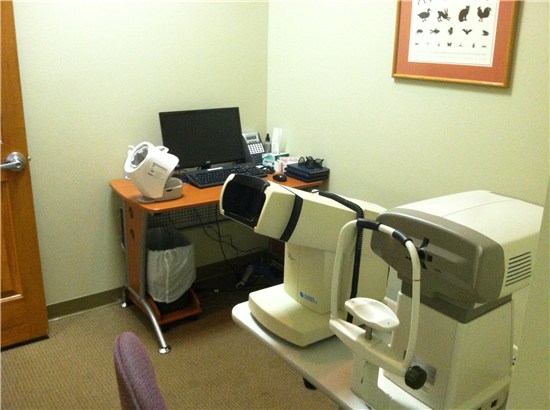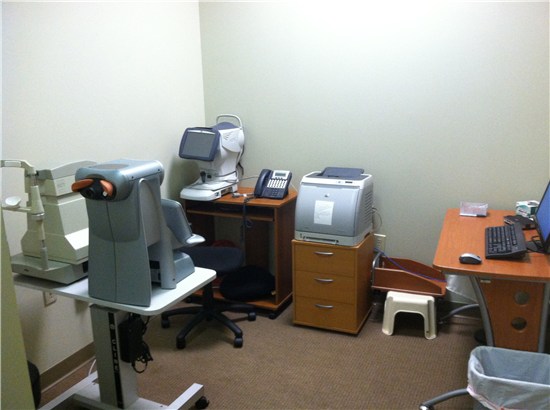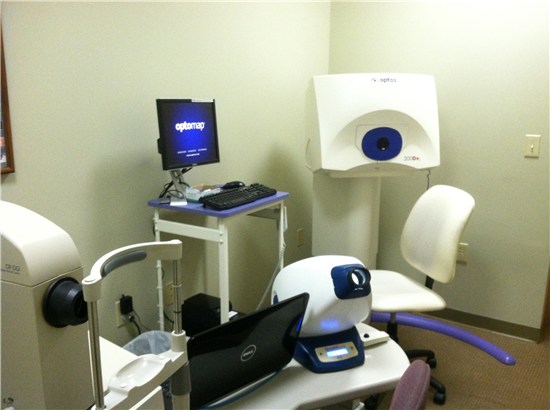By Yoongie Min, OD

Bottlenecks in the pre-testing area reduce time that patients spend in the optical dispensary following an exam. Time lost on shopping for eyewear is costly, as the dispensary typically generates two-thirds of revenues. An effective renovation of the pre-testing area can eliminate bottlenecks—and pay off in eyewear sales.
 The room where initial pre-testing takes place in Dr. Min’s office.
The room where initial pre-testing takes place in Dr. Min’s office.If your office carefully schedules patients to avoid creating too tight a schedule for doctors and support staff, and yet patient flow bottlenecks still occur, it may be time to look at your pre-testing area. In our case, the pre-testing stage of the patient experience was the place where the flow of traffic through the office was most likely to get held up. Moving patients through more smoothly means providing patients with a superior experience in your office. We all have busy lives, so a patient who has to wait before or during their appointment means a patient who probably won’t be happy with the experience.
I think many optometric offices were designed and built before our scope of practice expanded and before the explosion of technology. Therefore, we built pre-testing rooms (if we had them at all) that were used to do a few simple tests such as tonometry or visual fields. However, with the rapid growth of technology, especially imaging technology, our pre-testing and ancillary testing areas need to expand and retain flexibility for changes over time. Here are some of the ways we reduced the chances of a delay in service during appointments.
Move to a Different Part of Office
We moved our pre-testing area to a different part of the office a few months ago. We noticed that our pre-testing was sometimes backing up our exam flow because our technicians do so much in pre-testing and are entering all the related information into our electronic records. Elderly patients who take longer to pre-test, and new patients who also take longer to pre-test, were sometimes taking over 20 minutes to pre-test.
 The second pre-testing room patients move into after completing initial testing.
The second pre-testing room patients move into after completing initial testing.Renovation May Be Necessary
We moved our pre-testing area to a part of the office where the doctor’s private office used to be and the doctor’s office to where the old pre-testing area was. This involved putting up some new drywall, cutting some doorways, changing some flooring, moving some cabinets, changing some electric outlets, adding switches, painting and trim work. Our renovations cost less than $6,000 and we found a contractor that did all the work on weekends while we were not in the office. It took him about five to six weekends of work to complete everything. Since he was able to do almost everything while patients were not there, it really did not disrupt our schedule much at all.
Purchase Additional Instrumentation
Our previous pre-testing area had an autorefractor/keratometer, non-contact tonometer, visual fields, blood pressure testing, color and stereovision testing, Optomap retinal imaging, MPOD (macular pigment testing), corneal topography (when needed) and digital retinal photography (when needed). We purchased a new three-in-one unit that does autorefraction/keratometry/tonometry with one instrument that we have put in our new pre-testing area.
We tried to leave some extra room to add more equipment in the future. We are not sure exactly what pieces we will add, but definitely plan on adding a few more pieces of technology.

The room where patients go who require specialty testing such as via the practice’s Optomap.
Allow for Simultaneous Pre-Testing
The time for pre-testing is not significantly reduced, perhaps by a few minutes. However, we have designed the new pre-testing area differently so that two patients can be started simultaneously.
Bottlenecks are avoided because we now have a “triple” pre-testing area. We have two separate areas where patients can be started at the same time if needed. These areas have computers to enter medical history and previous optical information such as previous contact lens or eyeglass prescription information. They also have the capability of doing autorefraction, keratometry, and tonometry in both areas. We then set up a middle area that both areas feed into. The middle area has the testing that is optional for our patients that we do not do on every single patient. This includes Optomap, MPOD testing and digital retinal photography. If there is a wait to do Optomap, for example, it is only a minute or two usually. Most of the time, we still only use one pre-testing area, along with the middle area, but on busier days or when patients are running early or late, it gives us the flexibility to start another patient workup.
Our new area is approximately 120 square feet larger than our previous area. Our new combined pre-testing areas are approximately 350 square feet.
Create Smooth Flow, But Leave Time to Listen and Accommodate
We have trained our staff to be efficient to avoid bottlenecks during pre-testing. However, we also have a very patient friendly practice, so we try to be good at listening to patients and what they are telling us during pre-testing, even if it is long-winded at times. In addition, as our population gets older, people sometimes simply move more slowly, respond more slowly, and are sometimes using canes, walkers and wheelchairs that slow the process down. We try to anticipate all of these needs to keep the patient experience as high-quality as possible.
Related ROB Articles
Track Patient Time in Office: Do They Have Time to Shop?
Streamline Office Flow–and Leave Time for the Dispensary
Patient Comfort: The Little Stuff Pays Off Big Time
Yoongie Min, OD, is the owner of Northwest Vision Center, with locations in Columbus and Chillicothe, Ohio. To contact him: yminod@rrohio.com.



























